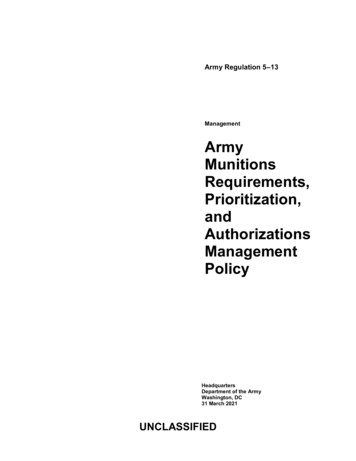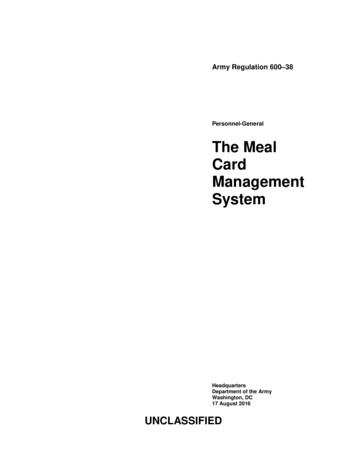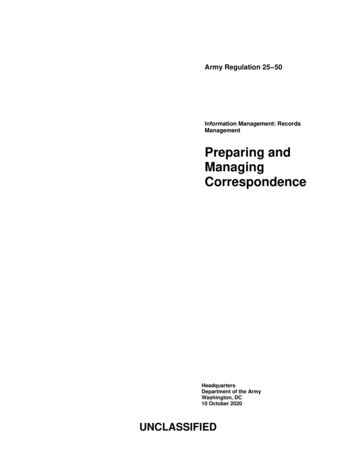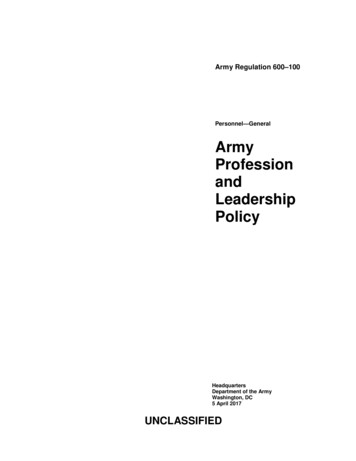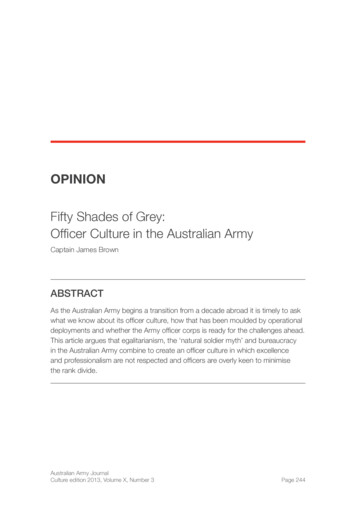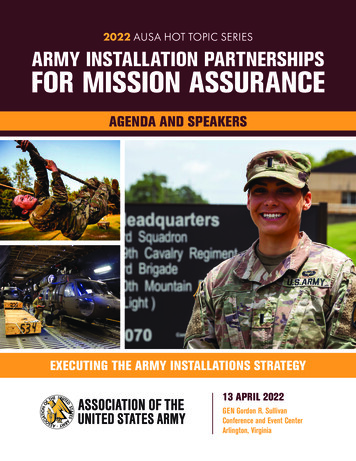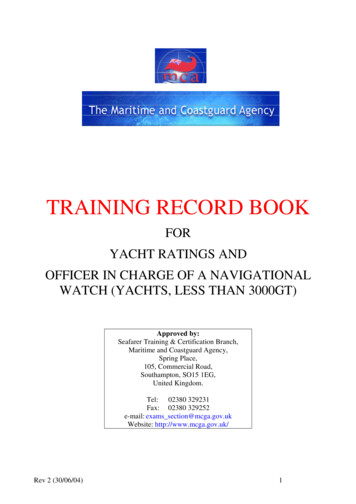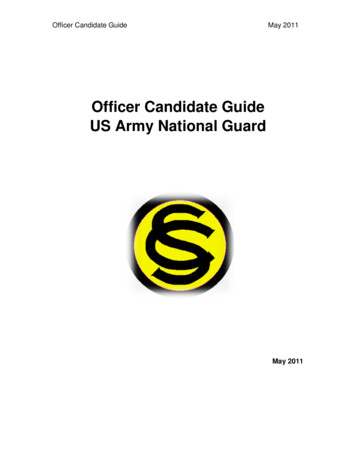
Transcription
Officer Candidate GuideMay 2011Officer Candidate GuideUS Army National GuardMay 2011
Officer Candidate GuideMay 2011Officer Candidate School, Reserve ComponentSummary. This pamphlet provides a guide for US Army National Guard Officer Candidate School students andcadre.Proponent and exception authority. The proponent of this pamphlet is the Commanding General, US ArmyInfantry School. The CG, USAIS has the authority to approve exceptions to this pamphlet that are consistent withcontrolling laws and regulations. The CG, USAIS may delegate this authority, in writing, to a division chief within theproponent agency in the grade of Colonel or the civilian equivalent.Intent. The intent of this pamphlet is to ensure that National Guard OCS Candidates nationwide share onecommon standard. It facilitates the cross-state and cross-TASS region boundary training of US Army officercandidates.Use of the term “States”. Unless otherwise stated, whenever the term “States” is used, it is referring to theCONUS States, Alaska, Hawaii, the US Virgin Islands, Territory of Guam, the Commonwealth of Puerto Rico, andDistrict of Columbia.Supplementation. Local OCS programs may supplement this document in order to meet the needs of local SOPsand regulations, but they may not substantially modify any policy set forth in this document without writtenauthorization from the proponent.Suggested improvements. Users are invited to send comments and suggested improvements on DA Form 2028th(Recommended Changes to Publications and Blank Forms) directly to the OCS SME, 200 Regiment, FortMcClellan, Alabama 36205.Distribution. This publication is available in electronic media only and is intended for all Reserve Component OCScadre and students.* This pamphlet supersedes all Federal and ARNG Student Guides dated prior to 1 May 2008i
Officer Candidate GuideMay 2011TABLE OF CONTENTSCHAPTER 1 - ORIENTATIONPARAGRAPH1-1Gender Statement1-2Applicability1-3Mission1-4Course Overview1-5Course Standards1-6Requirements for Graduation with Honors1-7Student Honors1-8DefinitionsPAGE11111222CHAPTER 2 – earance2-4Candidate Preparation2-5Contraband2-6Religious PracticesR2-7Leavingthe Company Area2-8Privately Owned Vehicle2-9Privately Owned WeaponsPAGE444466666CHAPTER 3 – PROCEDURESPARAGRAPH3-1Titles3-2Saluting, Addressing and Courtesies3-3Enter as Room / Addressing & Reporting3-4Making Way and Passing3-5Movement3-6Platoon Trainer “Shack” Procedures3-7Dining Facility Procedures3-8Sick Call3-9Classroom Procedures3-10Formations3-11Accountability and Reporting3-12Miscellaneous Rules3-13MailPAGE7778899999999CHAPTER 4 – HONOR CODEPARAGRAPH4-1General4-2Provisions of the Honor Code4-3Honor CouncilPAGE101011ii
Officer Candidate GuideMay 2011CHAPTER 5 – CANDIDTE RELIEF, RECYCLE, ns5-4Approval Authority5-5Removing Soldiers from POI TrainingRecommendation/Procedures for Recycle and5-6Relief5-7Candidate Resignations5-8Candidate RightsPAGE1212121212131516CHAPTER 6 – LEADERSHIP RATINGS & REPORTSPARAGRAPH6-1General6-2Evaluation Tools6-3Leadership Counseling6-4Army Values6-5Core Leader competencies6-6Leadership Attributes6-7Leadership Positions6-8Leadership EvaluationsPAGE1818192020222323CHAPTER 7 – ORGANIZATION OF CANDIDATE COMPANIESPARAGRAPH7-1General7-2Duties of the Chain of Command7-3Using the Chain of Command7-4Five Paragraph Operations OrderPAGE25252829CHAPTER 8 – TRAININGPARAGRAPH8-1Pre-OCS Requirements8-2Phase I Requirements8-3Phase II Requirements8-4Phase III RequirementsCHAPTER 9 – REQUIRED KNOWLEDGEPARAGRAPH9-1RequirementsAPPENDIX A – PACKING LISTPARAGRAPHInsert locallyAPPENDIX B – CANDIDATE PAGE
Officer Candidate GuideB-1B-2B-3B-4May 2011Subject AreaAssignmentAssignment InformationCover Sheet FormatB-1B-1B-1B-2APPENDIX C – CLOTHING & EQUIPMENT DISPLAYSPARAGRAPHInsert LocallyPAGEC-1APPENDIX D – CONTRABANDPARAGRAPHD-1ContrabandPAGED-1APPENDIX E – SENIOR STATUSPARAGRAPHE-1GeneralE-2Senior Candidate UniformE-3Senior Candidate PrivilegesPAGEE-1E-1E-1APPENDIX FSAFETYF-1F-2F-3F-4SAFETY AND COMPOSITE RISK MANAGEMENTPurposeThe Three Tiers of SafetyThe Risk Management ProcessFormsivF-1F-2F-2F-2
Officer Candidate GuideMay 2011Chapter 1ORIENTATION1-1. Gender Statement. All references to the male gender throughout this document apply to both sexes unlessotherwise indicated.1-2. Applicability. This guide applies to all candidates assigned to or attached to Reserve Component OfficerCandidate School.1-3. Mission. Train selected personnel in the fundamentals of leadership and basic military skills; instill theprofessional and physical fitness ethic; evaluate leadership potential; and commission those who qualify as secondlieutenants in the Total Force.1-4. Course Overview.a. General: Reserve Component OCS is a 12- to 15-month (traditional program) or 8-week (acceleratedprogram) Leaders’ Course of Instruction, taught in a high-stress environment, during which the cadre develop andevaluate the performance of the candidates as it relates to their potential for commissioning as second lieutenantsin the Total Force.b. Program of Instruction (POI): United States Army Infantry School (USAIS) prepares, publishes, anddistributes the OCS Course Management Plan (CMP) and Program of Instruction (POI). The course of instructionwill not exceed 16 months and is presented in three phases. The OCS Battalion or Company Commander directsphase advancement, dependent on class performance.(1) Pre-OCS. Although not a formal POI phase, traditional OCS programs typically conduct athree-IDT period Phase 0 program. This phase consists of instruction in basic soldier skills, drill and ceremony,physical training, and administrative preparation. The goal is to prepare prospective candidates to succeed in OCS.(2) Phase I. Consists of one 15-day annual training period. Training focuses on the individual,squad and platoon levels. Candidates receive military subject, land navigation, and leadership training under highstress conditions. Candidates in Phase I maintain a climate of strict discipline as the cadre show the candidatesOCS standards and then expect the candidates to meet these standards. Candidates train under extremelydemanding mental and physical conditions.(3) Phase II. In the traditional program, Phase II occurs during IDT weekends, between the first andsecond annual training periods; in the Accelerated Program, Phase II is a four week ADT period. Phase II ischaracterized by increased Platoon Trainer officer teaching and a slight reduction in stress producing situations.Training focuses on the individual, squad and platoon levels. During this phase, candidates continue to perfect theskills learned in the basic phase and strive for tactical and small unit leadership skills and confidence. Candidateswill assume additional responsibilities designed to refine their leadership skills through additional challenges ofmaintaining a completely functional student chain of command.(4) Phase III. Consists of one 15-day annual training period. Training occurs at individual, squad,and platoon level; with the focus on tactical operations and field leadership. Officer candidates focus on polishingleadership skills. The Platoon Trainer officer role is that of a teacher, mentor and role model. This phase is the finalrefining of the candidate done by the cadre to ultimately prepare the candidate for the officer environment.1-5. Course Standards.a. The standards required of an Officer Candidate will be of the highest order. Character and integrity mustbe an inspiration to others and conduct at all times must be above reproach. Personal appearance, military bearingand military courtesy will be of the highest standard at all times.b. Officer Candidates must meet the following standards necessary for graduation from OCS.(1) ACADEMICS. Pass all examinations. (Chapter 8, Training)(2) LEADERSHIP. Serve in various command positions during all phases of training and achievean overall satisfactory leadership rating. (Chapter 6, Leadership Ratings and Reports)(3) MORAL CHARACTER. Each Officer Candidate must have high moral character considerednecessary for a commissioned officer. (Chapter 4, Honor Code)(4) MEDICAL. Each Officer Candidate must pass a physical examination as prescribed forappointment as an officer in AR 40-501.1
Officer Candidate GuideMay 2011(5). PHYSICAL FITNESS. Each Officer Candidate must score a minimum of 60 points on eachevent of the Army Physical Fitness Test (APFT) with a minimum total score of 180 points, IAW NGR 600-100 andTC 3-22.20 (Army Physical Fitness). A large portion of the OCS environment is physical conditioning and requiresstamina. Each Officer Candidate must participate in scheduled physical training. Candidates must complete allfoot marches within prescribed standards. During Phase I candidate will complete a 5 mile foot march. DuringPhase II candidates must complete a 7, 10 mile foot march and a three mile release run. Candidates who fail tomeet the standard will be allowed one retest. (Chapter 5, Relief, Recycle, and Resignation)(6) WEIGHT STANDARDS. All Officer Candidates must meet the weight standards as published inAR 600-9. (Chapter 5, Relief, Recycle, and Resignation)(7) ATTENDANCE. Each Officer Candidate is expected to attend ALL training periods.Candidates who miss or cannot actively participate in 12 or more hours of scheduled training may berecommended for recycle. (Chapter 5, Relief, Recycle, and Resignation).1-6. Requirements for Graduation with Honors.a. All candidates are encouraged to strive for excellence. The earning of a student honor by a candidate isvery prestigious and is indicative of the attainment of excellence throughout the course. The criteria for studenthonors focus on the “whole person” concept and require the candidate to have excelled in physical fitness,academics and leadership. To be eligible for student honors, candidates must meet all graduation requirements.b. Officer candidates receive honor awards based on their performance in four major areas of the course:Academics, APFT #2, leadership evaluations, and peer evaluations. Any candidate that failed any of the threemajor areas and had to retest, excluding leadership evaluations, will not be in the running for an honor award. A‘not satisfactory’ on a leadership evaluation does not disqualify a candidate from being considered for honorawards.1-7. Student Honors.a. Erickson Trophy Recipient / Distinguished Honor Graduate. This award is given to the top candidate ineach OCS class in each state. This award is presented by the authority of the Department of the Army and the AirForce, National Guard Bureau and signifies distinguished leadership and academic ability.b. Academic There is ten end-of-module exams given in Phases I and II of OCS. These exams areaveraged for a total academic average (Note: Only the land navigation overall score is counted for the academicaward. If a candidate failed any of the tests and had to retest, then that candidate will not be considered for theacademic award.) The average of all ten exams will be the determination for the academic award. Failure in anyother event (APFT, foot march, leadership evaluation) does not disqualify a candidate from being eligible forconsideration for the academic award.c. Leadership Excellence Award. This award is presented to the candidate with the highest overallleadership evaluation score. This award signifies the candidate who excelled in the leadership aspect of OCS andis in recognition of their superior leadership abilities.d. Physical Fitness Award. In determining the physical fitness award winner, the overall average of APFTstaken throughout the course will be considered, and the APFT extended scale will be used. A candidate who failsan APFT, and has to re-test in any of the three foot marches or the three mile release runs will not be consideredfor the physical fitness award.e. Other Awards Determined by Each Battalion or State1-8. Definitionsa. OFFICER CANDIDATE (OC). An Officer Candidate is a selected applicant undergoing intensive militarytraining and evaluation to qualify as an officer in the Army National Guard or the US Army Reserve. The standardsrequired to qualify any candidate as an officer regardless of anticipated branch assignment are those prescribed foran Infantry Second Lieutenant. Students enrolled in OCS will be referred to as “Officer Candidate”.b. Platoon Trainer Officer. A Platoon Trainer Officer is a selected officer whose primary function is toTEACH, ASSESS and COUNSEL those candidates assigned to him/her in order to maximize the development oftheir leadership ability. All Platoon Trainer officers, regardless of rank or position, are selected based onknowledge, experience, dedication and the ability to foster and evaluate leadership performance and potential.2
Officer Candidate GuideMay 2011c. Candidates may not fully understand the leadership development process until they have gained theperspective of time and experience. Some of the methods Platoon Trainer Officers use in the performance of theirduties are:1. Observation2. On-the-spot correction3. Company/Platoon address4. Formal instruction5. Reprimand6. Informal individual performance counseling7. Formal individual performance counseling8. Written evaluation reports9. Written leadership evaluations10. Peer reportsc. Platoon Trainer NCO. The Platoon Trainer NCO is generally assigned at the platoon level. A Platoon TrainerNCO is a selected NCO whose primary function is to TEACH, ASSESS and COUNSEL those candidatesassigned to him/her in order to maximize the development of their leadership ability. The NCO is an essentialcomponent in the command structure of the Army. In the OCS environment, the Platoon Trainer NCO worksdirectly with the Platoon Trainer Officer and in his/her absence takes charge of the platoon. The Platoon TrainerNCO assists in planning and executing platoon missions and trains the platoon in individual and collective tasks.The methods Platoon Trainer NCOs use in the performance of their duties are the same listed above for thePlatoon Trainer Officer.d. SENIOR Platoon Trainer Officer. The senior Platoon Trainer Officer will monitor and supervise leadershiptraining of the candidates and still have the overall responsibility for leadership development and administrativeaffairs.3
Officer Candidate GuideMay 2011Chapter 2POLICIES2-1. General. The policies established at OCS provide uniformity and information for evaluating the candidate’sability to follow instructions, pay attention to detail and demonstrate leadership. The policies prescribed requirestrict compliance. Failure to comply may result in disciplinary action, recycle or relief.2-2. Fraternization.a. Relationships between candidates and cadre which cause the actual or perceived appearance ofpreferential treatment or partiality are prejudicial to good order, discipline and unit morale. Candidates and cadreare not authorized to form such relationships.b. Fraternization includes, but is not limited to sexual relationship with candidates and cadre, public displayof affection, to include close dancing, handholding, touching, kissing or other similar contact.c. Fraternization between candidates is unacceptable; it has the potential to undermine unit esprit andcause unnecessary tension within the class. Candidates will refrain from all actions that are, or could be perceivedas, fraternization.2-3. Appearance.a. An Officer Candidates appearance makes a statement about the individual’s personal organization, prideand attention to detail. Officer Candidates will maintain the highest standards of appearance and always set apositive example. Wear and appearance of Army uniforms will be in strict accordance with AR 670-1, except wherespecific changes are outlined in this candidate guide.b. Uniforms. Keep all uniforms clean and neat in appearance. Keep boots clean at all times. Wear identificationtags at all times. Carry your military identification card with all uniforms except the physical training uniform.c. Hair.(1) Male Candidates must wear their hair IAW AR 670-1. Extreme, fad style haircuts or hairstylesare not authorized. Hairstyles that prevent the uniform headgear or protective mask from being worn properly arenot authorized. Male Officer Candidates are to be clean-shaven; mustaches and sideburns are not authorized.(2) Female Candidates: Time allowed for grooming is very limited at OCS. Females should arrivewith a hairstyle that conforms to AR 670-1 even during physical training. Hairstyles will not interfere with the properwearing of military headgear or protective masks. Hair holding ornaments (such as but not limited to, barrettes,pins, clips, bands) if used, must be unadorned and plain and must be transparent or similar in color to the hair, andwill be inconspicuously placed. Candidates are not authorized to wear cosmetics.d. Civilian Clothing. Candidates will wear civilian clothing only at the direction of the OCS CompanyCommander. When in civilian attire, candidates will conform to the same appearance standards previouslyprescribed.2-4. Candidate Preparationa. Drill and Ceremonies. Candidates must study and become thoroughly familiar with FM 3-21.5 (Drill andCeremonies). One reading of the FM 3-21.5 will not suffice. A sound, thorough knowledge of Drill and Ceremonieswill be of great value to the Officer Candidate. * Specific attention should be paid to chapters 2 through 7 *b. Physical Fitness. The intent of the physical fitness training program at OCS is to educate each OC onthe basics of individual and unit physical fitness and improve the physical fitness of each candidate. It emphasizesrunning, tactical road marching, endurance, and upper body strength. As future leaders, Officer Candidates areexpected to wholeheartedly embrace and exemplify the Army concept of Total Fitness as set forth in TC 3-22.20and related publications. Physical fitness has a direct impact on combat readiness. With this in mind, the followingmust be accomplished prior to Phase I:(1) Acquire a proper pair of running shoes.(2) Pass the Army Physical Fitness test (APFT) given by the parent RTI/OCS Battalion/OCSCompany within 60 days preceding Phase I.(3) Arrive properly conditioned and capable of moving at the double time for extended distances.4
Officer Candidate GuideMay 2011The objectives of the OCS Physical Fitness Program are:(1) Teach OCs the basics of physical fitness.(2) Teach OCs the proper method of conducting physical fitness. Through study of TC 3-22.20 beprepared to lead warm-up exercises and calisthenics.(3) Assist the OCs in achieving and maintaining a high level of physical fitness.(4) Develop esprit-de-corps/unit cohesion.c. Academics. Officer Candidates should review the following references prior to arriving at Phase 1:(1) Drill and Ceremonies (FM 3-21.5)(2) Army Physical Readiness Training (TC 3-22.20)(3) Map Reading and Land Navigation (FM 3-25.26)(4) Training Units and Developing Leaders for Full Spectrum Operations (FM 7-0)(5) Army Leadership (FM 6-22)d. Clothing and Equipment. An Officer Candidate's appearance makes a statement about the individual'spersonal organization, pride and attention to detail. In observance of that fact, Officer Candidates will maintain thehighest possible standard of appearance through proper wear and care of the appropriate uniform. In addition tothis, all Officer Candidates will be uniformly dressed for whatever task or situation that they are in.(1) It is the Officer Candidate’s responsibility to make sure that he has in his possession allauthorized and required items. Diligence and persistence are often necessary. If after every effort to acquire thenecessary clothing and equipment from your home unit is unsuccessful, contact the respective Regional TrainingInstitute (RTI) for guidance and assistance.(2) Boots. Boots must be broken in thoroughly before beginning OCS.1. Blisters and related foot problems will cause candidates to miss training. If this occurs, itwill be directly attributable to failure to prepare.2. Boots are expected to be clean and maintained with an appropriate suede cleaning kit.3. Trousers will be bloused unless otherwise directed.e. Uniforms. There is only one type of uniform required for Phase 1.(1) ACU minimum 5 sets. Uniform items will not be mixed. Each student must acquire andmaintain the high standards of personal appearance of the officer corps. It is expected that the Officer Candidatewill set his uniform standard for the remaining years of their career. Those students who have uniforms that showconsiderable wear or that are ill-fitting will correct those deficiencies prior to reporting to Phase I.a. Embroidered nametapes and U.S. Army tape will be IAW AR 670-1, Paragraph 28-22.b. Officer Candidates will not wear ribbons, awards, decorations, unit patches, U.S. flag,combat patches, or other insignia upon reporting to Phase I. Subsequent wear of ribbons, awards, decorations andunit patches, U.S. flag, combat patches, and other insignia will be permitted at the discretion of the SR PlatoonTrainer.c. Candidates will wear their uniforms as prescribed in AR 670-1 and the directives of theOCS Battalion.(2) Physical Fitness Uniform (PT), minimum 2 sets.a. Improved Physical Fitness Uniform (IPFU).b. Plain white socks will be worn with the top above the ankle but below the calf.c. One pair of running shoes as preferred by the Officer Candidate that are of subduedcolors and appropriate for soldiers.f. Equipment.5
Officer Candidate GuideMay 2011(1) The Kevlar helmet is the prescribed headgear for OCS, unless stated otherwise. The helmet isworn with the chinstrap fitting snugly on the chin. Officer Candidates are required to have a soft cap in theirpossession at all times.(2). Load bearing equipment (LBE) will be worn IAW Appendix C. The poncho will be neatly foldedand secured to the rear of the pistol belt on the LBE, IAW Appendix C. Excess straps on the LBE will be folded uptoward the adjustment buckle in a 1-inch fold and secured with green tape. LBE may be substituted by the LBV.(3) Two canteens will be worn on the pistol belt over the hip pockets. Canteens will be full whenLBE is worn, empty while in wall locker. Canteen cup will be carried inside the canteen cover.g. Clothing and Equipment Displays: All clothing and equipment will be displayed IAW OC Guide. Alldisplays will be uniform throughout the Officer Candidate Company.2-5. Contraband. Contraband is defined as any item that is destructive to the good order and discipline, health,welfare, or safety of the soldier or unit. The Company Commander must approve all over-the-counter medicine.See Appendix D for contraband list.2-6. Religious Practices.a. Candidates will have an opportunity to participate in religious activities when possible. Religious activitieswill be IAW local SOP.b. Accommodating religious practices. A candidate may submit a written request for accommodation of areligious practice(s) to the Company Commander for consideration.2-7. Leaving the Company Area.a. When leaving the company area (i.e. sick call, etc.), candidates sign out IAW local SOP.b. The Company or Battalion Commander is the only one who may excuse a candidate from a scheduledclass.c. The Company Commander, First Sergeant, or Senior Platoon Trainer are the only ones who can grantpermission for a candidate to leave the company area.2-8. Privately Owned Vehicles. Refer to local SOP.2-9. Privately Owned Weapons (POWs).a. There isn’t any place for POWs or Law Enforcement weapons in OCS training. Address regulatoryconcerns IAW unit SOP through the chain of command.b. The carrying or possession of the following weapons is prohibited: unregistered firearms or pellet guns,switchblade knives, knives with fixed blades, knives with blades in excess of three inches in length, brass knuckles,leaded canes, gas dispensers, starter pistols, explosive devices (to include ammunition), projectiles, num-chucks,devices designed or altered to permit its use as an unregistered weapon, blackjacks, rappers, raps, or other relateddevices, and pyrotechnics of any type for other than authorized use.c. Candidates will turn in any unauthorized weapon IAW local SOP.6
Officer Candidate GuideMay 2011Chapter 3POLICIES3-1. Titles. Candidates will be identified by the title of “Officer Candidate [Last Name]. Senior Officer Candidateswill be addressed as “Senior Officer Candidate [Last Name}3-2. Saluting, Addressing and Courtesies.a. Saluting. Salutes will be rendered IAW FM 3-21.5 (Drill and Ceremonies). To further emphasizesaluting, attention to detail, and being cognizant of ones surroundings, saluting distance will be that distance atwhich a candidate recognizes an officer.b. When addressed by an officer, a candidate stands at the position of attention. Candidates reply, “Sir,Officer Candidate [Last Name].” When addressed by an NCO, candidates will stand at parade rest and respond,“Sergeant, Officer Candidate [Last Name].” When addressing either an officer or NCO, the candidate will lookdirectly into the eyes of the officer or NCO he is addressing.c. Greetings. An appropriate greeting will be extended when saluting (i.e. “Sir, Officer Candidate, *name*,Good Morning, Sir!”). When in groups of two or more, the Officer Candidate in charge will call the group toattention and render the salute and proper greeting. The Officer Candidate greeting the officer will continue to doso until the salute has been returned, the command “Carry On” has been given, or the officer is no longer in view.When moving as a group the first Officer Candidate in file or the Officer Candidate in charge will greet the officer.Greetings will not be extended at the double time. Candidate in charge will slow to quick time; render the saluteand proper greeting (without stopping forward motion), and return to double time after the salute is returned.(1) When addressing groups of officers and/or NCOs only the senior member of the group shall beaddressed.(2) If the senior member of the addressed group is accompanied by a member of equal grade thenthe senior members will be addressed as Gentlemen, Ladies, or Ma’am/Sir as appropriate.(3) Proper greetings are determined by local time.a. Morning is from 0001 to 1159.b. Afternoon is from 1200 to 1759.c. Evening is from 1800 to 2400.d. All greetings are concluded with Sir/Ma’am as appropriate.d. When initiating conversation with cadre, candidates must “Request permission to speak.” This is notrequired when saluting or rendering military courtesies.e. During duty hours, when an officer enters the company area/barracks, the first candidate to see theofficer will command, “Company/Platoon/Squad/Group, Attention.” Conversely, if any NCO without an officerpresent enters the area, the area will be called "At ease." All candidates who hear the command will respondappropriately. When the officer/NCO replies “Carry on” candidates will continue their activities.f. When an officer or NCO enters the platoon area the first candidate to see him will call “Attention” for anofficer and “At ease” for a NCO. The nearest platoon leader or platoon sergeant will report to the officer/NCO withthe platoon status.3-3. Enter a Room, Addressing/Reporting Dismissing.a. Enter a room. Candidates will assume the position of attention, center themselves in the doorway andtoe the line (the line is the imaginary line between the center of the doorframe, parallel to the doorway), knock threetimes with the palm of the right hand on the right door frame. The candidate will wait till the person in the roomaddresses the officer candidate, then the candidate will announce “Sir/Ma’am [as appropriate], Officer Candidate[Last Name] requests permission to enter.” The candidate will wait at the position of attention until told to enter.Once told to enter, the candidate will enter and walk directly to a position of two steps and centered in front of thedesk (or officer’s location), assume the position of attention, and simultaneously render the hand salute whilesaying, “Sir/Ma’am, Officer Candidate [Last Name] reports as ordered / with a question / with a statement” Thecandidate will execute order arms when the officer returns the salute.7
Officer Candidate GuideMay 2011b. Addressing/Reporting(1) To a commissioned officer: When addressed by an officer the Officer Candidate will come to theposition of attention and state his name as follows, “Sir/Ma’am, Officer Candidate *name* reports with astatement/question/as ordered”. During the conversation, the Officer Candidate will preface any comment, answeror reply with “Sir/Ma’am, Officer Candidate *name*”. The comment, answer, reply will not conclude with Sir/Ma’amunless the reply is “Yes” or “No” or is otherwise directed in this guide. When reporting to an officer the OfficerCandidate will come to the position of attention, render a salute and report, “Sir/Ma’am Officer Candidate *name*,reports!” If the Officer Candidate has been ordered to report, the candidate will add, “As ordered!”(2) To a non-commissioned officer: Same as above with the exception of the hand salute andOfficer Candidates will use the term “Sergeant” or “Sergeant Major” instead of “Sir/Ma’am”.c. Dismissing.(1) From a commissioned officer: When the conversation is complete and the Officer Candidate isdismissed, the Officer Candidate will come to the position of attention, take one step to the rear with the left foot,render the salute, extend the greeting of the day “Sir/Ma’am Officer Candidate *name*. Good Morning / Afternoon /Evening, Sir/Ma’am!” After the salute has been returned the OC will execute an about face and exit.(2) From a non-commissioned officer: Same as above with the exception of the salute and OfficerCandidates will use the term “Sergeant” or Sergeant Major” inst
Officer Candidate Guide May 2011 i Officer Candidate School, Reserve Component Summary. This pamphlet provides a guide for US Army National Guard Officer Candidate School students and cadre. Proponent and exception authority. The proponent of this pam

